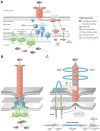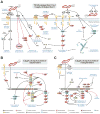Role of the cag-pathogenicity island encoded type IV secretion system in Helicobacter pylori pathogenesis
- PMID: 21352489
- PMCID: PMC3070773
- DOI: 10.1111/j.1742-4658.2011.08035.x
Role of the cag-pathogenicity island encoded type IV secretion system in Helicobacter pylori pathogenesis
Abstract
Helicobacter pylori is a very successful human-specific bacterium worldwide. Infections of the stomach with this pathogen can induce pathologies, including chronic gastritis, peptic ulcers and even gastric cancer. Highly virulent H. pylori strains encode the cytotoxin-associated gene (cag)-pathogenicity island, which expresses a type IV secretion system (T4SS). This T4SS forms a syringe-like pilus structure for the injection of virulence factors such as the CagA effector protein into host target cells. This is achieved by a number of T4SS proteins, including CagI, CagL, CagY and CagA, which by itself binds the host cell integrin member β(1) followed by delivery of CagA across the host cell membrane. A role of CagA interaction with phosphatidylserine has also been shown to be important for the injection process. After delivery, CagA becomes phosphorylated by oncogenic tyrosine kinases and mimics a host cell factor for the activation or inactivation of some specific intracellular signalling pathways. We review recent progress aiming to characterize the CagA-dependent and CagA-independent signalling capabilities of the T4SS, which include the induction of membrane dynamics, disruption of cell-cell junctions and actin-cytoskeletal rearrangements, as well as pro-inflammatory, cell cycle-related and anti-apoptotic transcriptional responses. The contribution of these signalling pathways to pathogenesis during H. pylori infections is discussed.
© 2011 The Authors Journal compilation © 2011 FEBS.
Figures



Similar articles
-
Role of type IV secretion in Helicobacter pylori pathogenesis.Cell Microbiol. 2008 Aug;10(8):1573-81. doi: 10.1111/j.1462-5822.2008.01156.x. Epub 2008 Apr 8. Cell Microbiol. 2008. PMID: 18410539 Review.
-
Type IV Secretion and Signal Transduction of Helicobacter pylori CagA through Interactions with Host Cell Receptors.Toxins (Basel). 2017 Mar 24;9(4):115. doi: 10.3390/toxins9040115. Toxins (Basel). 2017. PMID: 28338646 Free PMC article. Review.
-
The Helicobacter pylori Type IV Secretion System Encoded by the cag Pathogenicity Island: Architecture, Function, and Signaling.Curr Top Microbiol Immunol. 2017;413:187-220. doi: 10.1007/978-3-319-75241-9_8. Curr Top Microbiol Immunol. 2017. PMID: 29536360 Review.
-
Helicobacter pylori exploits a unique repertoire of type IV secretion system components for pilus assembly at the bacteria-host cell interface.PLoS Pathog. 2011 Sep;7(9):e1002237. doi: 10.1371/journal.ppat.1002237. Epub 2011 Sep 1. PLoS Pathog. 2011. PMID: 21909278 Free PMC article.
-
Expression of CEACAM1 or CEACAM5 in AZ-521 cells restores the type IV secretion deficiency for translocation of CagA by Helicobacter pylori.Cell Microbiol. 2019 Jan;21(1):e12965. doi: 10.1111/cmi.12965. Epub 2018 Nov 8. Cell Microbiol. 2019. PMID: 30321907
Cited by
-
Epstein Barr virus and Helicobacter pylori co-infection are positively associated with severe gastritis in pediatric patients.PLoS One. 2013 Apr 24;8(4):e62850. doi: 10.1371/journal.pone.0062850. Print 2013. PLoS One. 2013. PMID: 23638154 Free PMC article.
-
Associations of lung cancer risk with biomarkers of Helicobacter pylori infection.Carcinogenesis. 2022 Jun 27;43(6):538-546. doi: 10.1093/carcin/bgac047. Carcinogenesis. 2022. PMID: 35605986 Free PMC article.
-
Prevalence of Helicobacter pylori cagA and iceA Genes and Their Association with Gastrointestinal Diseases.Int J Microbiol. 2018 Apr 5;2018:4809093. doi: 10.1155/2018/4809093. eCollection 2018. Int J Microbiol. 2018. PMID: 29849647 Free PMC article.
-
Mechanism and structure of the bacterial type IV secretion systems.Biochim Biophys Acta. 2014 Aug;1843(8):1578-91. doi: 10.1016/j.bbamcr.2013.12.019. Epub 2014 Jan 2. Biochim Biophys Acta. 2014. PMID: 24389247 Free PMC article. Review.
-
Helicobacter pylori CagL Y58/E59 mutation turns-off type IV secretion-dependent delivery of CagA into host cells.PLoS One. 2014 Jun 3;9(6):e97782. doi: 10.1371/journal.pone.0097782. eCollection 2014. PLoS One. 2014. PMID: 24893039 Free PMC article.
References
-
- Peek RM, Jr, Crabtree JE. Helicobacter infection and gastric neoplasia. J Pathol. 2006;208:233–48. - PubMed
-
- Amieva MR, El-Omar EM. Host-bacterial interactions in Helicobacter pylori infection. Gastroenterology. 2008;134:306–323. - PubMed
-
- Viala J, Chaput C, Boneca IG, Cardona A, Girardin SE, Moran AP, Athman R, Mémet S, Huerre MR, Coyle AJ, DiStefano PS, Sansonetti PJ, Labigne A, Bertin J, Philpott DJ, Ferrero RL. Nod1 responds to peptidoglycan delivered by the Helicobacter pylori cag pathogenicity island. Nat Immunol. 2004;5:1166–1174. - PubMed
Publication types
MeSH terms
Substances
Grants and funding
LinkOut - more resources
Full Text Sources

